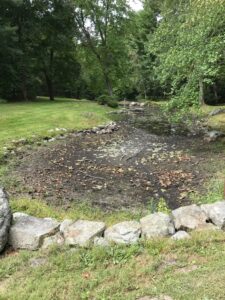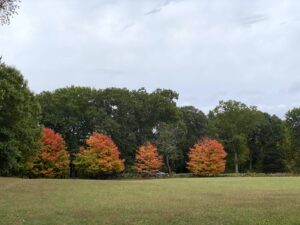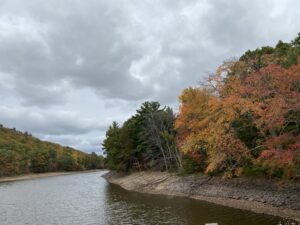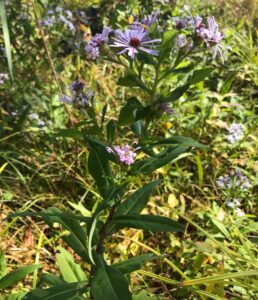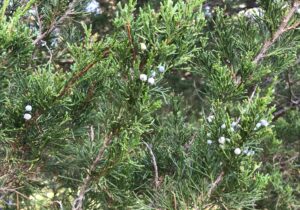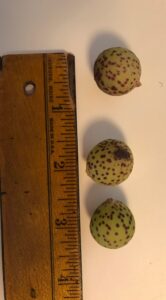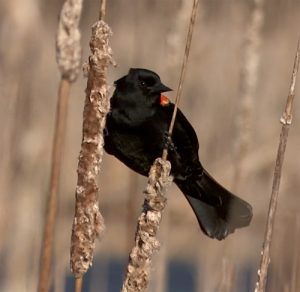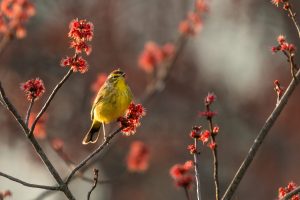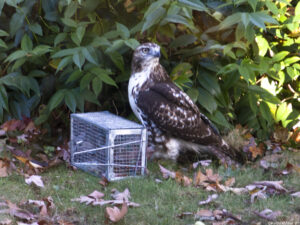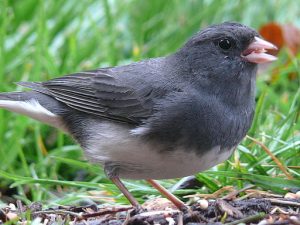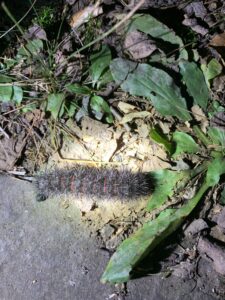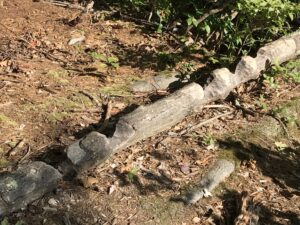Written by Gwyn Loud for the Lincoln Land Conservation Trust. She welcomes your sightings and questions at 781-259-8690 or gwynloud555@gmail.com.
We need rain! Hopefully, the steady rain on Oct. 13 will give us at least an inch (it did). For five months, starting in May, we have not met the monthly rainfall average, putting Middlesex County into the severe drought category, designated by the US Drought Monitor. According to the UMass Landscape Message, “Soils are dry and trees and shrubs are stressed, and signs of this stress are evident including early fall color, leaf drop, wilting foliage, and canopy dieback.” Farmers at Drumlin Farm wrote on Sept. 21, “Root harvests have been made easier by the lack of rain; it’s as if everything is buried in sand and lifts right out. We would trade that ease for the water the carrots and cabbage really need right now.” Low-lying fields and gardens had light frosts on September 15 as well as a few subsequent dates. Even a few feet in elevation makes a difference, however, so some of us are frost-free, still harvesting tomatoes and beans. A very short but fierce wind storm, a derecho, blew though Lincoln on Oct. 7, toppling trees and power lines, with many roads blocked. These wind events seem increasingly common.
In spite of the drought, we are seeing fall color such as red foliage on sumacs, red maples, and Virginia creeper, with Norway maples and birches turning yellow. Wildflowers such as goldenrod and Joe-Pye weed became dry and brown early, but several species of asters are displaying their white or lavender blossoms.
This is the season for an abundance of seeds and berries, all important wildlife food. I have been watching birds eating berries on poison ivy and Virginia creeper twining up trees, and the blue berry-like fruits on junipers. Juniper “berries” are actually not berries but are female cones with very fleshy and merged scales.
If you come across a little green sphere under an oak tree you have found an oak apple gall. Galls form on numerous plants and are a “house” instigated by an insect, often a wasp, which lays its egg on a plant leaf or stem. The insect gives off chemicals which prompt the host plant to create a structure around the egg and when the larva hatches it also emits secretions, stimulating the plant to make the gall bigger. Inside, the larva has food from plant tissues, shelter, and protection from enemies, although mice, woodpeckers, and red squirrels may pierce the gall to eat the occupant. Unless eaten by a predator, the insect larva eventually digs its way through the side of the gall and flies off as an adult.
Fall bird migration is well underway, with noisy flocks of grackles, cowbirds, and red-winged blackbirds passing through, as well as many song birds. October is sparrow month. At Drumlin Farm recently five species of sparrow were observed: chipping, Savannah, Lincoln’s, song, and swamp. Elsewhere, white-throated sparrows arrived and they will be with us all winter, often feeding on the ground under bird feeders. The last ruby-throated hummingbird I noticed was on Sept. 21 and by now it should be sipping nectar in Central America or the West Indies. Migrating wood warblers, in their rather drab winter plumage, have dropped down to feed during daylight hours, fattening up for their overnight flights. Yellow-rumped warblers are the most common warblers, but observers have also seen black-throated blue, blackpoll, pine, American redstart, and at Drumlin Farm, thirty-two palm warblers were counted. Eastern phoebes, blue-headed and red-eyed vireos, scarlet tanagers, indigo buntings, and American pipits are other migrants reported. Red-breasted nuthatches seem suddenly numerous; if their food supply in Canada is poor, they may stay for the winter in what is called an “irruption”. An observer was impressed to see, “dozens of chickadees and red-breasted nuthatches feeding on the ground on a particular place in Mount Misery two days in a row.”
A recent notable avian sighting was a peregrine falcon, rarely reported here. Osprey were seen over Farrar Pond, and turkey vultures have been spotted overhead, soaring south. Juvenile red-shouldered and red-tailed hawks were making persistent calls in late September and a Baker Bridge Rd. resident found a young red-tail looking perplexed as it tried to get to a chipmunk captured in a Hav-a-hart trap.
For those who feed birds, October is a good time to set up feeders, encouraging local winter birds to add you to their restaurant route. I have already had the first dark-eyed junco under my feeders, a species which will be here for the winter. Several purple finches also visited; they are often confused with house finches, which are far more common. Birds need water year-round, so if possible, set up a heater to keep birdbaths ice-free. Project Feederwatch, a citizen science project you might enjoy, starts in November; check it out at feederwatch.org.
Bumblebees, primarily males at this time, and many looking very worn, are still foraging on flowers but only the queens will survive the winter, hibernating in shallow underground holes. Norman Levey writes about hearing jumping bush crickets on warm evenings, a species new in our area over the last decade: “They are cold tolerant and will chorus at a slower beat when we get into the fifties, will survive a few killing frosts.”
As temperatures fall, many adult insects die and others go into a resting period called diapause, overwintering as eggs or larvae. A familiar larva is the woolly bear caterpillar, with brown and black bristles. It will overwinter curled up in a sheltered spot and wait until spring before spinning a cocoon and then hatching into an Isabella tiger moth. Another bristly caterpillar seen recently was a giant leopard moth.
The Mass. Department of Agricultural Resources (MDAR) is urging us all to watch for a new invasive insect, the spotted lantern fly, likely imported from other states on plants, landscape materials or outdoor furniture. So far only two dead specimens have been found in Massachusetts. MDAR writes, “Residents should look for large, gray insects, about one inch long, with black spots and red underwings, or inch-long, rectangular yellowish-brown egg masses covered with a gray waxy coating. Egg masses may be found on any flat surface. If any indication of SLF is found, residents should take a photo or collect the specimen, and report any potential sightings of the pest using MDAR’s online reporting form.”
Although no bear was actually seen, probable evidence of its presence was found in large scat, both along the gas pipeline trail and in the Ricci Field, a location where two beehives were also overturned. Young male bears seek out new territories and are gradually extending their range eastward from central Mass. Coyotes have been howling all over town and many residents have noticed woodchucks, which will hibernate once cold weather comes. Black squirrels, once only reported from the Farrar Pond neighborhood, have recently been spotted at Drumlin Farm and Ricci Field. They are not a separate species, simply a gray squirrel with a faulty pigment gene. Deer have been damaging crops at Drumlin Farm. The farmers wrote on Sept. 29,” We spotted three new fawns running out of the fields this morning, bringing to 13 the number of individual deer we’ve counted out there. Our two solar chargers and electric fence set-ups are deployed around carrot patches, and, so far, have been effective…. Deer are now eating cilantro, radish, bachelor buttons, and next year’s strawberry crop.” Beavers have been busy chewing down trees by various ponds; could the photo below be a practice log for young beavers?!
Looking skyward, Mars is visible throughout October and November, the brightest it will be until 2036, and Jupiter is high in the sky all evening. The full moon on Halloween will be a blue moon, as it will be the second full moon of the month.
© Gwyn Loud


